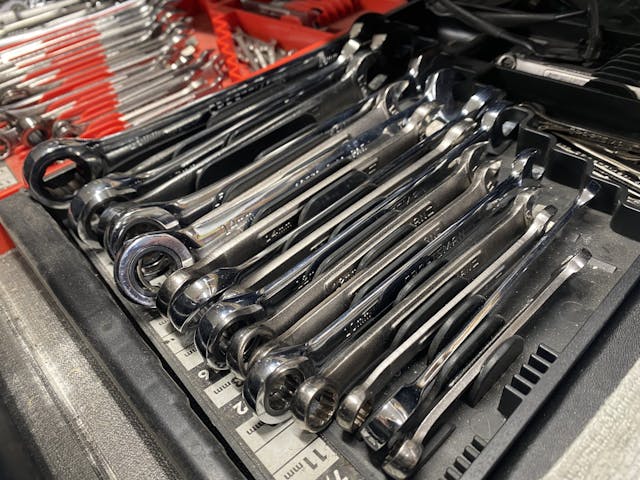Are you using the right combination wrench for the job?
There aren’t many times when talking points come up in the garage, but when they do it’s all about wrenches. The vast majority of nuts and bolts are hexagonal in nature, meaning six flats for a wrench or socket to engage. For ease of use, many combination wrenches are open-end on one side and a 12-point design on the other. More expensive versions often have the open-end paired with a six-point box end. Is it really worth the money and hassle of use to get a six-point set?
There is tons of anecdotal evidence from lots of gearheads, but if you are looking for some hard numbers it can be hard to find. Luckily Torque Test Channel on YouTube put its rig designed for testing impact wrenches to use and set up a formal test on just what wrench and socket might be best. The test included 12-point, six-point, spline, and the open end.
The setup is pretty simple: use each wrench to tighten a soft hex nut that is attached to a rig that can measure the clamping force imparted. Since a thread is basically an inclined plane, the more rotations completed by the nut, the more clamping force is imparted on the testing rig. Each wrench was used to the point of rounding off an already partially rounded fastener. Sometimes that meant using additional leverage, but not always. The fastener was partially rounded at the start to give a real-world angle to the test. It is rare that we see perfect hardware in the wild, and if we do it is rarely what causes us headaches.
The open-end wrench did the worst. This should surprise no one. Two points of contact just cannot take the force needed to tighten or loosen a bolt with great force. Some of this comes to wrench tolerance and sizing accuracy and considering most of us are using wrenches on corroded or damaged hardware it is even more important to use the right tool correctly to prevent damaging hardware.
Next up was the 12-point which did markedly better than the open-end wrench but varied between the Gearwrench and Craftsman brand tested. This makes sense due to the difference in production quality, but this is also a bit anecdotal since only one wrench from each brand was tested. There is a possibility that one is the best ever produced by that brand and the other is one that barely passed quality control.

The six-point wrenches were the best yet, and for good reason. There is the most engagement with the fastener on the flats rather than only the corners. This makes it a lot harder to round off the edges even if the bolt is already damaged or very soft material. Fascinatingly, the spline wrenches and sockets did a great job. Both the creator of the video and your humble author thought that spline wrenches were pretty gimmicky but when put to the test produced numbers right in line with or better than six-point. The only problem was they basically destroyed the fastener when they stripped, no flats or corners left at all to try and hammer a socket onto to try and salvage getting things apart easily.
So why not use only six-point wrenches and sockets when working on your projects? For sockets, there is basically no reason not to since a ratchet allows easy clocking to engage the nut. For wrenches, it’s not that easy though. Having only six flats means the wrench can only fit onto the bolt in six different positions. In a wide-open space, this is fine, but in a cramped engine compartment or suspension piece, this can be far from ideal. This is why most toolboxes have 12-point box wrenches. What is given up in the ability to really put force into a bolt is traded for the ease of use in having twice as many angles of attack. Take a look at the chart at the end of the video to see hard numbers for what works and what doesn’t.
Does this change your mind about which wrench you grab when you open your toolbox? Or maybe even convince you that a few tool purchases are in the near future? It certainly did for me.




